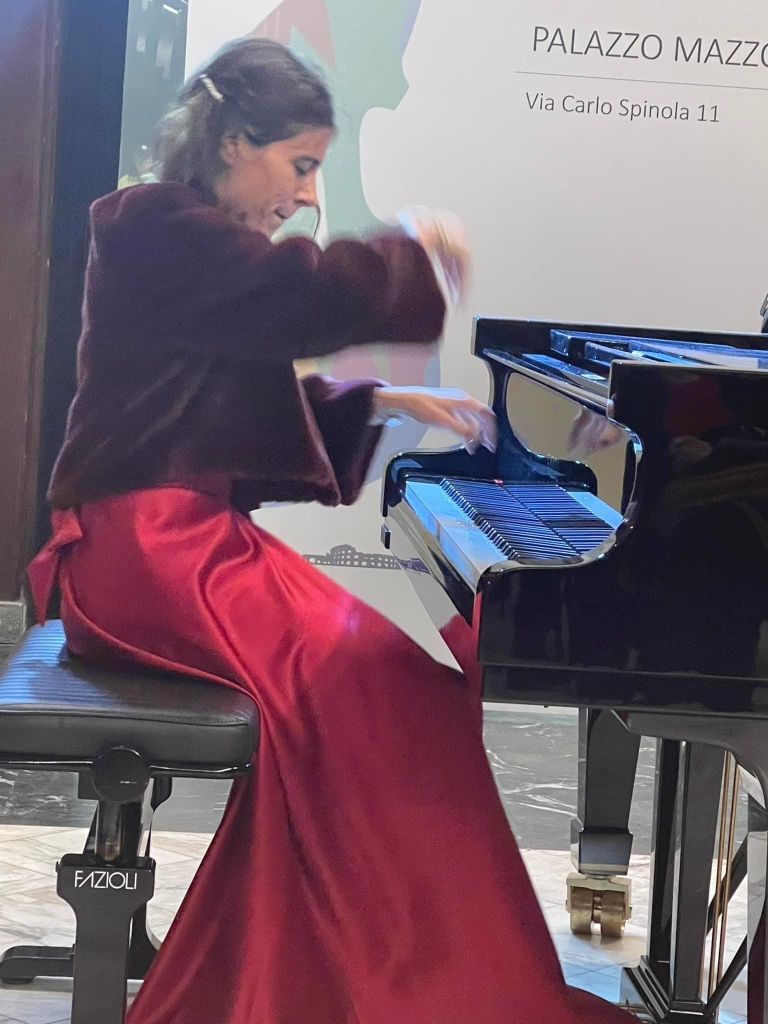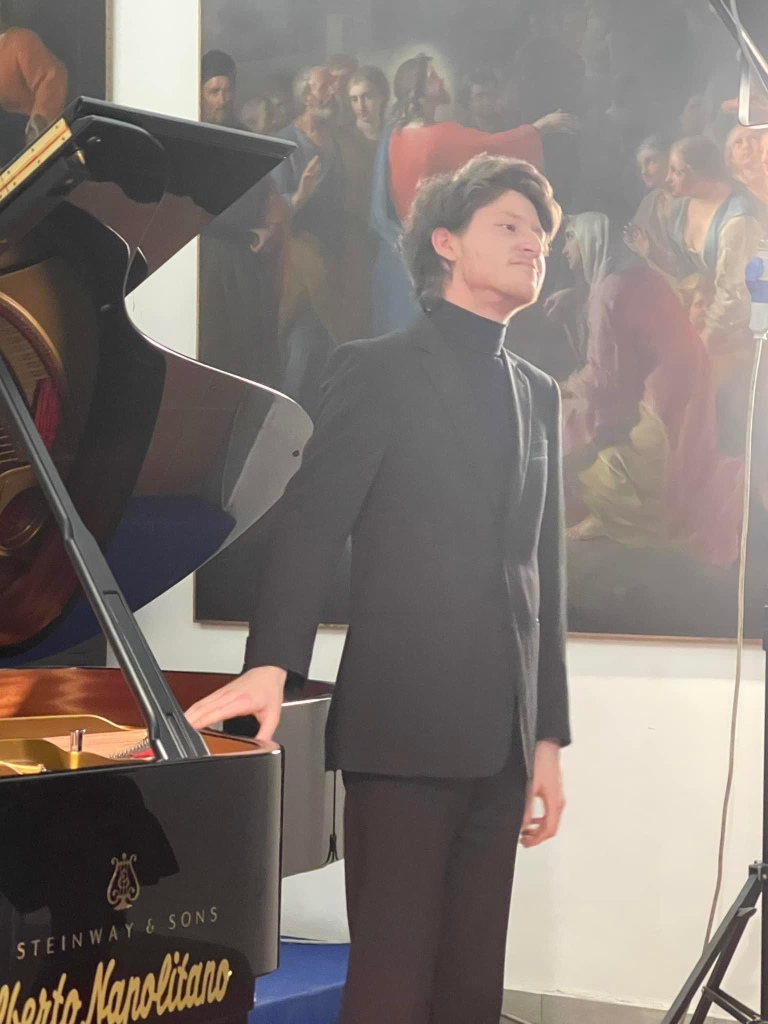Tuesday 3 January 3.00 pm


It was nice to see that the opening of the new season of concerts at St.Mary’s should be with a pianist who a few years ago gave a very promising recital at St Barnabas and now has returned to St Mary’s as a very refined artist.From a family of musicians she had from an early age received expert training from her father.Well trained fingers,musicianly performances of intelligence and sensibility.I well remember her scintillatingly diligent account of Schumann’s early Abegg Variations.Today we have seen the transformation of a prize winning student into an artist of stature.

From the opening flourish of the Bach Toccata that immediately caught our attention with her natural musicality allowing the music to flow with subtle natural shape.It was played with a sense of style both of nobility and aristocratic authority.I found her insistence on playing ‘non legato’ though not quite as natural as though someone had told her rather than her being convinced and allowing her natural musicality to lead her rather than someone else’s head!It did though create a contrast between the opening improvised flourish and the following fugato passages.But Bach is based on the song and the dance as Angela Hewitt and Andras Schiff have shown us – Nikolaeva was one of the first to allow Bach to flow naturally from her fingers.Rosalyn Tureck,of course was unique but was more monumental than natural as was her disciple Glenn Gould who took Bach to the extremes with genius and individuality.I well remember Shura Cherkassky playing this Partita to me in his hotel room in Florence.He had programmed it in his next concert programmes and just needed to try it out.Cherkassky was not known for his Bach playing but he imbued it with his unique colour palette and a natural musicality that has remained in my memory for its unaffected musicianship.Rose with her natural musicality allows the music to flow through her with naturalness and musicianship where rules and regulations should now have no place as was so clearly shown with her wonderfully mellifluous Chopin Nocturnes.

The Scarlatti Sonata in G that followed the Bach Toccata was played with clarity and rhythmic buoyancy.A delicacy and infectious ‘joie de vivre’of whispered fun and games.Even the chordal interruptions were unusually delicately placed that made the jeux perlé passages even more enticing.

The D major Sonata showed a commanding dexterity as she allowed a natural hand position to hover over the keys horizontally rather than in her Bach where they were almost vertical.A natural hand position that allowed her to let the music flow through her with searing controlled passion.These were jewels that sparkled and shone with scintillating rhythmic energy of subtle shaping and colour and a sense of timing that cannot be taught but is of great artistry.
Chopin: Nocturne in B Major Op 62 no 1

And what beauty she brought to the two Chopin Nocturnes.The B major was played with a wonderful sense of balance where the melodic line was allowed to sing with sensitivity and a rubato that was so natural.It could have flowed more ‘Andante’,though, as Chopin marks ,which would have made the ‘sostenuto’ of even greater contrast.The trills,poco piu lento and dolce,were played like beams of light vibrating in this ever more languid atmosphere.At the return to the original tempo she allowed the meandering embellishments to flow with all the time they needed to cast their magic spell.Strangely enough it was the ‘Lento sostenuto’ of the E flat Nocturne that flowed so poetically and naturally with insinuating counterpoints poignantly played.It gradually built in passion only to dissolve with magical embellishments to its final resting place.These were performances of great artistry and searing beauty of ravishing sounds and poetry.

I well remember listening astonished at the refined and subtle virtuosity of Leopold Godowsky in this very piece by Liszt.It was a performance from a piano roll that had recently come to light in Frank Holland’s Piano Museum in Brentford.Sidney Harrison ,my teacher,was very much involved in helping Frank ,who was not a musician but an engineer,in bringing these amazing performances to the attention of a discerning musical public.They were first heard on BBC programmes late at night where one could listen to these rediscovered performances of legendary pianists from the Golden Age of piano playing.One became ever more aware of a virtuosity that was as remarkable for its range of sounds not only from forte to fortissimo but more from mezzo forte to pianissimo.This was,of course before the arrival of Sviatoslav Richter in the west.Rose played it with a beautiful legato and subtle sense of rubato.Grandeur and delicacy turned this neglected work into the miniature masterpiece that it truly is.’Au Bord d’une source’ and ‘Ricordanza’ together with this study are true miniature masterpieces that are unduly neglected these days.Hats off to Rose for including it in her recital and placing it along side recognised masterpieces by Chopin

I had heard Rose play Debussy in a recital streamed from St James’s this summer and had been deeply impressed by her identification with this sound world.Today she not only chose four preludes but the extraordinary second book of Images.The multicoloured bells of ravishing sounds spread over the entire keyboard flowed from her entire body with such ease.Like a great painter spreading colour over the entire canvas with strokes of beauty where the sounds she was creating were mirrored in the movements that were making them.’Et La Lune descend ‘,sounds of echoed vibrations and melancholic recollections with a translucency of vibrant lyricism.Played with astonishing delicacy with sounds that at times were barely audible such was their rightful place in this poetic landscape.Have Debussy’s Gold Fish ever been allowed to wallow in such clear waters?An aristocratic French sound of vibrancy and urgency with a fluidity as Debussy asks ‘Expressif et sans rigueur ‘disappearing to a mere magical whisper.

Four Preludes were of great character and beauty .’Fairies’that were indeed ‘exquisite’and the magic rays of the moon shone so clearly as Ondine darted in and out of the picture.But it was the Fireworks that showed of her remarkable technical assurance where her authority and remarkable virtuosity were used to create a picture of extraordinary imagery.The Marseilles was allowed to shine in the distance over the smokey atmosphere that was all that was left after a multicoloured feast and dazzling display of sounds.

Rose McLachlan comes from a family of musicians and was born in Cheshire in 2002. She began piano lessons with her father and entered Chetham’s School of Music in 2010, initially as a chorister at Manchester Cathedral. She now studies piano with Helen Krizos. After gaining a high distinction for grade 8 at 11, Rose was awarded the LTCL performers diploma with distinction in 2017. Rose has already had considerable successes in national and international competitions. After being awarded the Sir David Wilcock’s Organ Scholarship in 2014/15 she was the overall winner of the 2016 Scottish International Youth Prize at the Royal Conservatoire of Scotland. As a result of winning the Yamaha Prize in the 2017 EPTA UK competition, Rose performed at St Martins in the Fields. As an overall winner of the Chetham’s concerto competition in February 2018, Rose was selected to perform the Ravel G major concerto with the Chetham’s Symphony Orchestra during the 2018-19 season. In 2018, Rose won the Chopin and Beethoven prizes at Chetham’s and in 2019 she was overall winner of the junior intercollegiate Beethoven Piano Society of Europe competition. Also, in 2019 Rose was the overall winner of the 11th “Dora Pejacevich” competition organized by EPTA Croatia. She has performed Beethoven’s second Piano Concerto five times with orchestra, as well as solo recitals in Lanzarote, St James Piccadilly, London, Portsmouth and Birmingham. With her family, Rose has given recital tours in Scotland. In March 2019, Rose performed the Clara Schumann concerto with the New Tyneside Orchestra in Newcastle conducted by Monica Buckland. 2018 saw her first commercial recording being issued by Divine Art, performing ‘Five Hebridean Dances’ by John McLeod. In October 2019 she performed Shostakovich’s Second Concerto with the BBC Concert Orchestra conducted by Barry Wordsworth in the Malcolm Arnold Festival which was broadcast on BBC Radio Three. As a result of this concert she was immediately invited to perform live at the Royal Festival Hall as a solo pianist on Radio 3 in a concert scheduled for 6 May 2020. In January 2020, Rose recorded piano duets by the distinguished British composer, Edward Gregson, with her father for a new commercial recording on the Naxos label. In 2021, Rose was a winner of the Pendle Young Musicians Bursary. In September 2021, Rose was a Tabor Piano Ambassador in the Leeds International Piano Competition, resulting in her first published article for the online Pianist magazine. In February 2022, Rose was the winner of the Kirklees Young Musician of the Year. Rose is now at the Royal Northern College of Music in Manchester, continuing her studies with Helen Krizos. She is extremely grateful to receive financial support from the Waverley Fund.



















































































































































